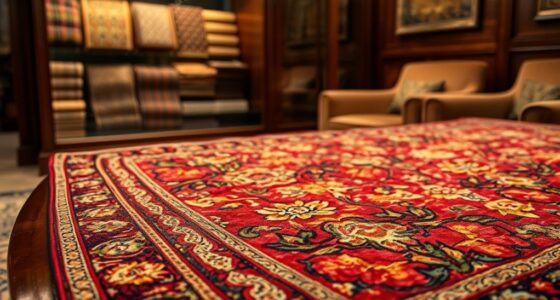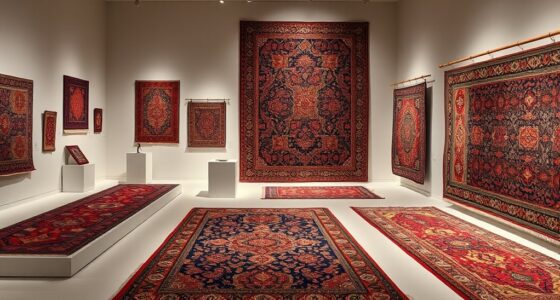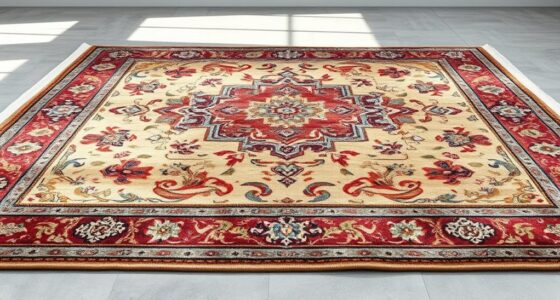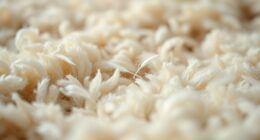In the 2025 fine-rug market, you’ll see volatility driven by economic shifts, geopolitical events, and changing demand. Trends favor vintage revival and eco-conscious designs, with regional demand mainly coming from the Middle East, Europe, and North America. Technology, like digital verification and online platforms, boosts transparency and trust. To succeed, focus on provenance, authenticity, and building credibility. Keep exploring to discover how these factors will shape opportunities and challenges in the upcoming market landscape.
Key Takeaways
- The 2025 fine-rug market will see increased emphasis on provenance, transparency, and authenticity verification to meet collector demands.
- Digital authentication tools and online platforms will dominate, expanding market access and real-time insights.
- Rarity, cultural significance, and high-quality craftsmanship will drive valuation and demand for luxury and collectible rugs.
- Market growth is expected in high-end segments, with a focus on provenance-rich pieces and virtual sales channels.
- Building trust through credible documentation and expert insights will remain essential for market stability and credibility.
Current Market Dynamics and Influences

Understanding the current market dynamics is essential for making informed decisions in the art world. Right now, market volatility is a key factor influencing the fine-rug sector, causing prices to shift unpredictably. You’ll notice pricing fluctuations as collectors and investors react to economic changes, geopolitical events, and shifts in demand. These fluctuations can create opportunities but also risks, so staying aware of current trends helps you gauge when to buy or sell. The global economy’s ups and downs directly impact the market’s stability, making it vital to monitor these influences closely. Recognizing how market volatility affects prices enables you to navigate the fine-rug market with confidence and strategic insight. Additionally, understanding market trends related to various cultural and regional influences can enhance your ability to anticipate future shifts. Paying attention to relationship dynamics among collectors and investors can also provide valuable insights into emerging patterns and shifts in demand. Keeping an eye on economic indicators can further improve your understanding of the market’s fluctuations and potential turning points. Being aware of market volatility and its causes helps you develop more resilient investment strategies in uncertain times. Moreover, staying informed about global economic shifts can help you better predict long-term trends in the fine-rug market.
Emerging Styles and Design Trends
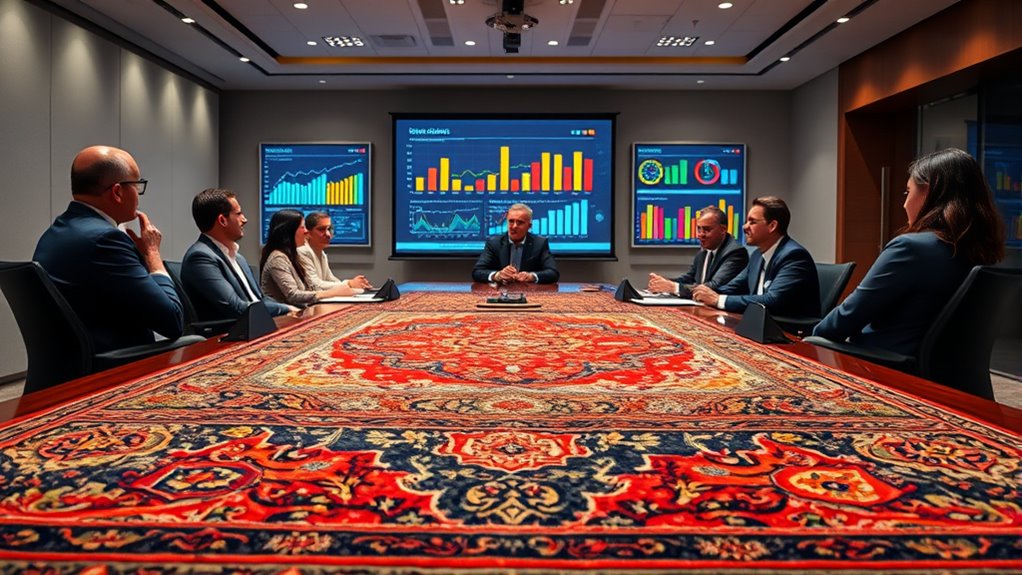
What new styles are shaping the future of fine rugs today? You’ll notice a strong vintage revival, blending classic motifs with contemporary twists. These designs evoke nostalgia while appealing to modern tastes, making them highly desirable. Eco-conscious designs are also gaining traction, emphasizing sustainable materials and environmentally friendly processes. This trend reflects a shift toward responsibility and authenticity in craftsmanship. Incorporating weather-resistant materials ensures longevity and durability in diverse environments. Additionally, the use of eco-friendly dyes supports sustainability in rug production. Incorporating sustainable fibers further enhances the eco-friendly aspect of modern rug design. Here’s a quick comparison:
| Vintage Revival | Eco-Conscious Designs |
|---|---|
| Focuses on traditional patterns | Uses sustainable, natural fibers |
| Combines old and new aesthetics | Prioritizes eco-friendly dyes |
| Resurrects historic techniques | Reduces environmental impact |
| Appeals to collectors seeking history | Attracts ethically-minded buyers |
| Adds timeless appeal | Promotes sustainability in design |
These emerging styles define the evolving landscape of fine rugs, blending tradition with responsibility.
Key Regions Driving Demand

Which regions are currently leading the demand for fine rugs, and what’s driving their popularity? The Middle East, Europe, and North America dominate the market, fueled by strong luxury branding and evolving collector preferences. In the Middle East, a deep appreciation for cultural heritage and exclusivity elevates demand for high-quality pieces. European collectors prioritize craftsmanship and provenance, aligning with their appreciation for fine artistry. North America’s growing interest in luxury branding and investment-grade rugs attracts both seasoned collectors and newcomers. These regions’ emphasis on authenticity, rarity, and prestige boosts market confidence. As collectors seek distinctive, high-value items, their preferences shape demand across these key markets, ensuring continued growth in the fine-rug sector well into 2025. Additionally, the influence of decorating styles like farmhouse and rustic aesthetics is increasingly evident in collector choices, further diversifying the market trends. Moreover, market stability remains a crucial factor driving sustained demand and investment interest in fine rugs. This stability is supported by the growing adoption of digital platforms for buying and selling, which enhances transparency and access for global buyers. Furthermore, the integration of ethical sourcing practices reassures buyers about the authenticity and sustainability of their acquisitions, reinforcing market confidence.
Technological Advancements Impacting the Industry
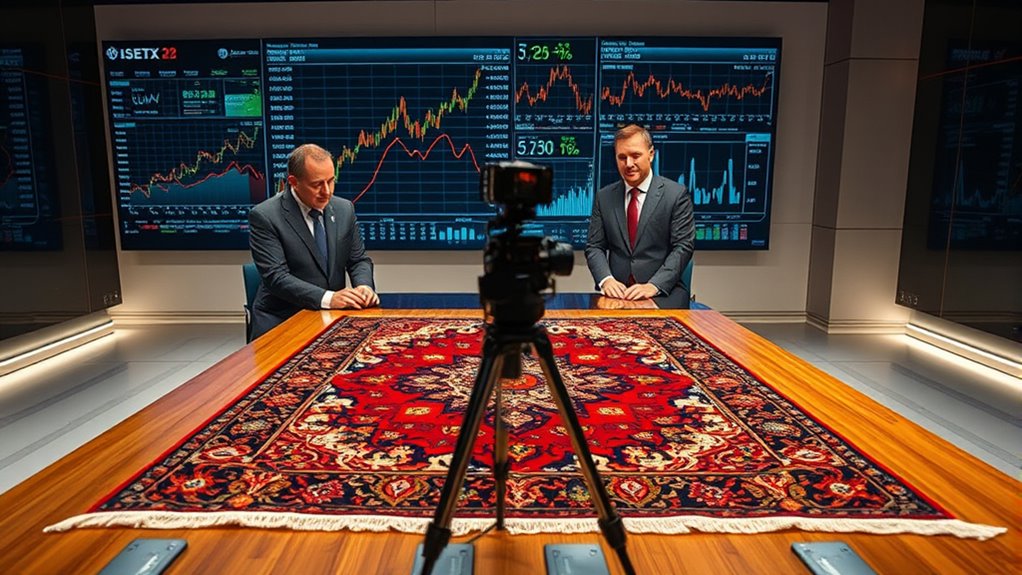
Technological advancements are transforming the fine rug industry by enhancing authentication, provenance tracking, and market accessibility. Digital authentication tools now enable you to verify a rug’s authenticity quickly and accurately, reducing the risk of forgery. These tools often use high-resolution imaging and database comparisons to confirm provenance and value. Additionally, AI-driven appraisals are streamlining valuation processes, providing precise estimates based on a rug’s unique features, history, and market data. This technology empowers you to make informed decisions, whether buying or selling. Moreover, online platforms leverage these innovations to reach a broader audience, democratizing access to high-quality rugs and real-time market insights. Implementing advanced technologies and other innovations in related industries demonstrates how innovation can improve overall quality and trust. The integration of digital verification methods further enhances confidence in the market, helping both buyers and sellers ensure authenticity. Market democratization is making it easier for collectors and investors of all sizes to participate confidently. Embracing these advancements ensures you stay competitive in a rapidly evolving industry. For example, the use of specialized imaging techniques can reveal hidden details and authenticity markers that are not visible to the naked eye, further strengthening trust.
Predictions and Strategic Insights for 2025

As the fine rug industry continues to evolve rapidly, strategic foresight will be crucial for staying ahead in 2025. Success will depend on understanding emerging trends in luxury branding and collector psychology, which are shaping purchasing behaviors. You should anticipate increased demand for provenance and authenticity, emphasizing transparency to attract discerning collectors. Digital platforms will continue to influence market dynamics, making online auctions and virtual exhibitions essential tools. Additionally, rarity and cultural significance will remain central to valuation strategies. Staying ahead requires cultivating a strong brand narrative and connecting emotionally with collectors. Embrace innovation while respecting tradition, ensuring your offerings resonate with evolving tastes and preferences. Incorporating authenticity verification processes can further build trust and credibility with buyers.
Frequently Asked Questions
How Will Geopolitical Tensions Affect Rug Prices in 2025?
You should expect geopolitical tensions to impact rug prices in 2025, as instability can disrupt trade and supply chains. When geopolitical stability declines, trade sanctions often tighten, reducing the availability of certain rugs and increasing their value. You’ll likely see prices fluctuate, especially for rare or region-specific pieces. Staying informed about global political developments can help you anticipate market shifts and make smarter buying or selling decisions.
What Role Do Private Collectors Play in Market Growth?
Imagine private collectors as the unstoppable engines fueling market growth! Your private investments and collector motivations create a ripple effect, driving demand for rare, exquisite rugs. Their passion for acquisition and preservation skyrockets prices and elevates the market to new heights. Without these dedicated collectors, the fine-rug market would lack vibrancy and innovation. Your role as a private collector is vital—shaping trends, fostering exclusivity, and ensuring the market’s extraordinary expansion.
How Are Sustainability Practices Influencing Rug Production and Sales?
Sustainability practices are transforming rug production and sales by emphasizing eco-friendly materials and dyes. You’ll notice more artisans using sustainable materials like organic wool and natural dyes, appealing to environmentally conscious buyers. These efforts not only reduce environmental impact but also boost market value, as consumers seek authentic, eco-friendly options. This shift encourages innovation and transparency, making sustainable rugs a growing segment in the fine-rug market.
Will Digital Marketplaces Outperform Traditional Auction Houses?
Imagine a race where digital innovation accelerates ahead of traditional auction houses. You might see digital marketplaces outperform in the future because they adapt quickly to changing consumer behavior, offering convenience and broader access. Data shows online sales increased by 20% last year, highlighting this shift. As more buyers prefer browsing from home, digital platforms become the front runners, transforming how fine rugs are bought and sold.
How Do Currency Fluctuations Impact International Rug Trading?
Currency fluctuations substantially impact your international rug trading. When exchange rates shift, your costs and profits can change unexpectedly, making it harder to price rugs accurately. You also face risks from import tariffs, which can increase expenses and decrease profit margins. Staying updated on currency trends helps you make smarter buying and selling decisions, protecting your margins despite unpredictable exchange rate movements and import tariffs.
Conclusion
As you navigate the fine-rug market in 2025, you’ll notice how recent trends and technological leaps intertwine seamlessly, shaping a vibrant industry. Coincidentally, as demand rises in key regions, innovative designs captivate collectors worldwide, creating a dynamic dance between tradition and modernity. Embrace these shifts, knowing that your keen eye and strategic insights will not only keep you ahead but also place you at the heart of an evolving, exciting marketplace.


